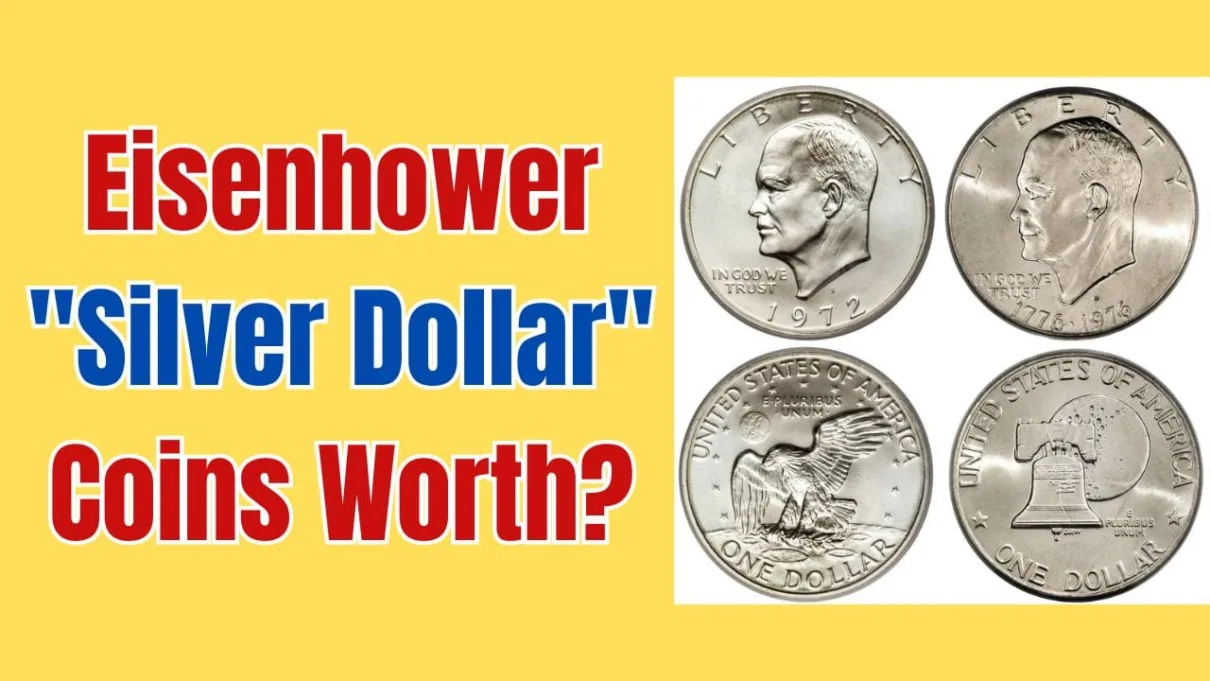Eisenhower “Silver Dollar” Coins: If you possess a $1 coin, it may hold a value significantly exceeding its face value. There are four methods to determine whether your coin could potentially be sold for nearly $14,000, as reported by many financial review platforms.
Currently, coins that are valued at approximately $13,500 feature President Dwight D. Eisenhower. Like all dollar coins, these coins bear the inscription “In God We Trust” on the obverse side, while the reverse displays an eagle along with the phrases “E Pluribus Unum” and “United States of America, One Dollar.” Numerous dollar coins are presently in circulation and available for purchase, with notable examples including the Sacagawea Gold Dollar Coin, the Seated Liberty Silver Dollar Coin, and the Peace Silver Dollar Coin, as noted by the U.S. Mint.

Eisenhower “Silver Dollar” Coins Worth?
The year 2025 may present a lucrative opportunity for many Americans seeking to generate additional income through coin sales. The market for rare coins is becoming increasingly vibrant, and numerous individuals are capitalizing on the sale of unique coins to secure financial gains, whether modest or substantial.
If one possesses a rare dollar coin, it could potentially be sold for around $13,500. While it is important to acknowledge that not all coins will yield such high returns, when one finds themselves in a favorable position, it is advisable to sell the coin to maximize profit.
Specifications of the Eisenhower Dollar
| Feature | Details |
| Designer | Frank Gasparro |
| Composition | Copper-nickel clad (circulation), 40% silver (collector’s editions) |
| Diameter | 38.1 mm |
| Weight | 22.68 grams (copper-nickel), 24.59 grams (silver) |
| Mint Marks | Philadelphia (none), Denver (“D”), San Francisco (“S”) |
New $200 Ontario Tax Rebate [Check Now]: Claim Your Money! Who Qualifies?
$2100 + $500/M GIS Extra Increase 2025: Is it True? CPP, OAS, GIS Updates Inside!
Eisenhower silver dollars
The United States Mint initiated the production of Eisenhower silver dollars in 1971 as a tribute to the deceased president and World War II veteran. On April 29, 1969, Congressman Robert Casey from Texas introduced a legislative proposal for this new one-dollar coin. Subsequently, on October 29, 1969, Congressman Robert R. Casey put forth another bill that designated the reverse side of the coin as homage to the Apollo 11 Moon landing.
The minting of these coins continued until 1978. Although the Eisenhower, commonly referred to as the “Ike” dollar, did not achieve widespread circulation, it has gained popularity among numismatists. The growing interest in the “Ike” series has resulted in the identification of various die varieties and errors. However, not all of these are documented in standard coin catalogs and valuation guides. Typically, the editors of these guides await a significant increase in collector interest for a specific die variety or error before assigning a value that would appeal to traditional collectors.
Furthermore, a sufficient sales history is necessary for editors to establish a published value. Among the most sought-after Eisenhower dollars is the 1972 Type 2, which can be easily recognized by examining the depiction of the moon on its reverse. To explore this notable Eisenhower silver dollar along with other varieties and errors, one can consult our guide on key dates, rarities, and varieties, and subsequently begin to enhance their collection.
What makes this $1 coin so unique?
If you possess an Eisenhower Dollar, it could be worth much more than its face value. Here’s how to check if it could be worth up to $14,000:
- President Featured: The coin features Dwight D. Eisenhower, the 34th U.S. President, and is part of a series minted from 1971 to 1978.
- Mint Mark: The most valuable coins from this series lack a mint mark (no “D” for Denver or “S” for San Francisco), which makes them rare.
- Condition: Coins in pristine or “mint” condition are worth more. Tarnished coins still hold value but less than those in top condition.
- Special Varieties: Certain years, like the 1972 Type 2, are particularly sought after by collectors. Look for unique die varieties or errors for increased value.
If your coin meets these criteria, it could be worth thousands! Always consult a professional to get an accurate assessment before selling.
AUSTRALIAN VISA to CITIZENSHIP: How to Fast track Australian Citizenship 2025?
Big News: $445 Family Benefit for Canadians in 2025– Don’t Miss Out!
Does It Have A Mint Mark?
If you happen to possess an Eisenhower coin, the crucial factor determining its value is the presence of a mint mark. This small letter, located on the coin’s obverse, reveals where it was struck. Between 1965 and 1967, mint marks were omitted from coins due to the Coinage Act of 1956, aimed at curbing the hoarding of certain coins by collectors. Although mint marks returned in 1967, the Eisenhower coins, which can fetch around $13,500, are notable for their absence of a mint mark. This rarity is what elevates their desirability among collectors.
What Is Its Condition?
In order to achieve its maximum market value, a coin should ideally be in “mint” condition. While a tarnished or aged Eisenhower coin may still hold a value exceeding one dollar, a pristine and well-maintained coin is likely to attract higher offers from collectors.
It is advisable to consult with a professional before selling any dollar coins you own. An expert in coins or antiques can accurately assess the value of your coin and help you avoid the risk of undervaluing your asset.
FAQs on Eisenhower Dollars Worth Up to $14,000
What is an Eisenhower Dollar?
The Eisenhower Dollar is a U.S. coin minted from 1971 to 1978, featuring President Dwight D. Eisenhower. It was produced to honor his legacy and commemorate the Apollo 11 Moon landing.
Why is my Eisenhower Dollar worth so much?
The rare unmarked Eisenhower Dollars (those without a mintmark) can be worth up to $14,000, as they are highly sought after by collectors.
How do I know if my coin is worth $14,000?
Check if your coin lacks a mintmark (no “D” or “S” indicating Denver or San Francisco mint). If it’s in excellent condition and free of damage, it could be worth a significant amount.
What is the best condition for selling?
Coins in “mint” or “uncirculated” condition (no wear, scratches, or tarnish) are the most valuable. Tarnished or damaged coins will still be worth more than face value, but less than those in pristine condition.
How can I get my coin assessed?
For an accurate valuation, consult a professional numismatist or coin dealer. They can help confirm if your coin is a rare, valuable variety.
Should I sell my coin?
If you believe your coin may be worth a significant amount, it’s best to consult a professional first to ensure you get the best price when selling.

